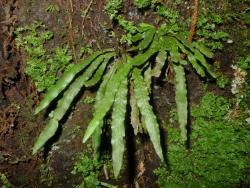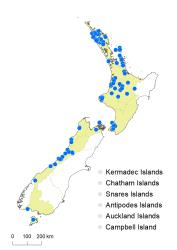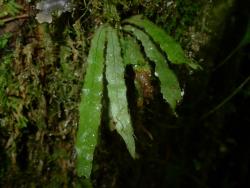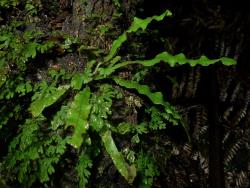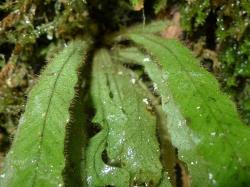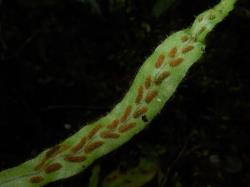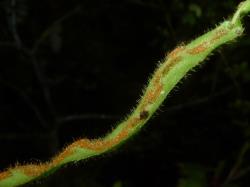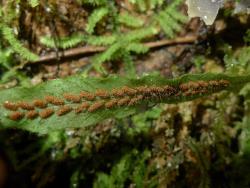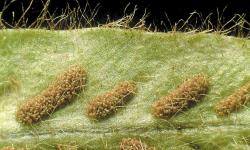- ≡ Grammitis pseudociliata Parris in Parris & Given, New Zealand J. Bot. 14: 106 (1976)
Rhizomes erect to short-creeping, bearing scales. Rhizome scales narrowly ovate, 1.6–5.4 mm long, 0.3–1.2 mm wide, pale red-brown, concolorous, non-clathrate. Stipes indistinct, winged almost to base, hairy. Stipe hairs abundant, pale red-brown, 0.2–1.8 mm long. Fronds undivided, narrowly elliptic or rarely narrowly obovate, 22–165 mm long, 3–12 mm wide; apices acute to obtuse; margins entire or shallowly scalloped, sometimes undulate; bases attenuate to an indistinct winged stipe; both surfaces pale green; herbaceous; bearing abundant pale brown hairs up to 1.2 mm long on the margins, and up to 1.5 mm long on the midrib and lamina surface. Hairs either setae, or branched hairs with setiform branches. Hydathodes present. Sori elliptic, elongated along veins, oblique, 1.2–5.2 mm long, in 2–32 pairs in mid to upper part of lamina, bearing pale brown hairs up to 1.8 mm long, usually longer than on the lamina surface. Sporangia 130–240 µm long; spores 20–33 µm diameter.
Notogrammitis pseudociliata is characterised by its erect to short-creeping rhizome, lack of distinct stipes, presence of hairs all over the frond and in the sori, presence of hydathodes and its lamina margin, which is often scalloped and undulate. It is almost exclusively epiphytic on podocarp or broadleaved forest trees. The erect rhizome, and presence of hairs on the frond and in the sori distinguish it from all other species except N. ciliata. However, N. pseudociliata is always epiphytic, and has larger fronds (22–165 mm long, 3–12 mm wide; cf. 9–100 mm long,1.5–6 mm wide), and lamina margins that are often scalloped and undulate rather than entire and flat.
North Island: Northland, Auckland, Volcanic Plateau, Taranaki, Southern North Island.
South Island: Western Nelson, Sounds-Nelson, Westland, Southland.
Stewart Island.
Altitudinal range: 5–975 m.
Notogrammitis pseudociliata occurs in lowland areas, extending locally into montane areas, from Kaitāia to Lake Taupō and Mt Taranaki, and in the Wellington region. It has also been observed in the southern Ruahine Range (iNaturalist 33414077), but the record is not mapped here. The species ranges from 120 m near Whangaroa Harbour to 975 m on Mt Taranaki and in the Pureora Forest Park, but is absent from much of the eastern North Island. In the South Island it is common only in Westland, with very scattered populations elsewhere on the western side of the island from the Marlborough Sounds to Stewart Island. It grows from near sea level up to 525 m on D’Urville Island.
Also Australia (Tasmania).
Notogrammitis pseudociliata is found in kauri, podocarp, broadleaved, and rarely in beech forest. It is an epiphytic species, almost always growing on podocarp or broadleaved trees, or very rarely on tree ferns or on rock. It has been recorded on Ackama rosifolia, Agathis australis, Beilschmiedia tarairi, B. tawa, Cupressus macrocarpa, Dacrycarpus dacrydioides, Dacrydium cupressinum, Dysoxylum spectabile, Elaeocarpus dentatus, Fuscospora fusca, Hedycarya arborea, Ixerba brexioides, Melicytus ramiflorus, Metrosideros robusta, Neomyrtus pedunculata, Olearia rani, Phyllocladus trichomanoides, Podocarpus laetus, Prumnopitys ferruginea, P. taxifolia, Quintinia serrata, Syzygium maire, Weinmannia racemosa, W. sylvicola, and rarely on tree fern trunks.
A count of n = c. 37 has been reported for this species in Australia (Parris 1998; Tindale & Roy 2002).



